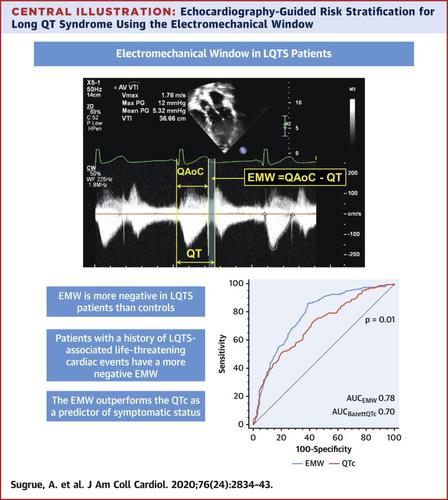当前位置:
X-MOL 学术
›
J. Am. Coll. Cardiol.
›
论文详情
Our official English website, www.x-mol.net, welcomes your
feedback! (Note: you will need to create a separate account there.)
Echocardiography-Guided Risk Stratification for Long QT Syndrome
Journal of the American College of Cardiology ( IF 21.7 ) Pub Date : 2020-12-01 , DOI: 10.1016/j.jacc.2020.10.024 Alan Sugrue , Martin van Zyl , Nick Enger , Katie Mancl , Benjamin W. Eidem , Jae K. Oh , J. Martijn Bos , Samuel J. Asirvatham , Michael J. Ackerman
Journal of the American College of Cardiology ( IF 21.7 ) Pub Date : 2020-12-01 , DOI: 10.1016/j.jacc.2020.10.024 Alan Sugrue , Martin van Zyl , Nick Enger , Katie Mancl , Benjamin W. Eidem , Jae K. Oh , J. Martijn Bos , Samuel J. Asirvatham , Michael J. Ackerman

|
BACKGROUND
The ability to identify those patients at the highest phenotypic risk for long QT syndrome (LQTS)-associated life-threatening cardiac events remains suboptimal. OBJECTIVES
This study sought to validate the association between electromechanical window (EMW) negativity, as derived from echocardiography, and symptomatic versus asymptomatic status in patients with LQTS. METHODS
We analyzed a cohort of 651 patients with LQTS (age 26 ± 17 years; 60% females; 158 symptomatic; 51% LQTS type 1; 33% LQTS type 2; 11% LQTS type 3; 5% multiple mutations) and 50 healthy controls. EMW was calculated as the difference between the interval from QRS onset to aortic valve closure midline, as derived for continuous-wave Doppler, and the electrocardiogram-derived QT interval for the same beat. RESULTS
A negative EMW was found among nearly all patients with LQTS compared to controls, with more profound EMW negativity in patients with symptomatic LQTS compared to those with asymptomatic LQTS (-52 ± 38 ms vs. -18 ± 29 ms; p < 0.0001). Logistic regression identified EMW, heart rate-corrected QT interval (QTc), female sex, and LQTS genotype as univariate predictors of symptomatic status. After multivariate analysis, EMW remained an independent predictor of symptomatic status (odds ratio for each 10-ms decrease in EMW: 1.37; 95% confidence interval: 1.27 to 1.48; p < 0.0001). EMW outperformed QTc in predicting symptomatic patients (area under the curve: 0.78 vs. 0.70; p = 0.01). After training and implementation, EMW correlation from echocardiographic sonographers showed excellent reliability (intraclass correlation coefficient: 0.93; 95% confidence interval: 0.89 to 0.96). CONCLUSIONS
In this validation study, patients with a history of LQTS-associated life-threatening cardiac events had a more profoundly negative EMW. EMW outperformed heart rate-corrected QT interval as a predictor of symptomatic status. EMW is now a clinically validated risk factor. In December 2019, our institution's echocardiography clinical practice committee approved use of EMW for patients with LQTS, making it a routinely reported echocardiographic finding.
中文翻译:

长 QT 综合征的超声心动图引导风险分层
背景 识别长 QT 综合征 (LQTS) 相关的危及生命的心脏事件的表型风险最高的患者的能力仍然欠佳。目的 本研究旨在验证来自超声心动图的机电窗 (EMW) 阴性与 LQTS 患者的有症状与无症状状态之间的关联。方法 我们分析了 651 名 LQTS 患者(年龄 26 ± 17 岁;60% 女性;158 名有症状;51% LQTS 1 型;33% LQTS 2 型;11% LQTS 3 型;5% 多突变)和 50 名健康人的队列控件。EMW 计算为从 QRS 开始到主动脉瓣关闭中线的间隔(从连续波多普勒推导)与心电图推导的相同搏动的 QT 间隔之间的差异。结果 与对照组相比,几乎所有 LQTS 患者的 EMW 均呈阴性,与无症状 LQTS 患者相比,有症状的 LQTS 患者的 EMW 阴性更明显(-52 ± 38 ms vs. -18 ± 29 ms;p < 0.0001) . Logistic 回归将 EMW、心率校正 QT 间期 (QTc)、女性和 LQTS 基因型确定为症状状态的单变量预测因子。多变量分析后,EMW 仍然是症状状态的独立预测因子(EMW 每降低 10 毫秒的比值比:1.37;95% 置信区间:1.27 至 1.48;p < 0.0001)。EMW 在预测有症状的患者方面优于 QTc(曲线下面积:0.78 对 0.70;p = 0.01)。经过培训和实施,超声心动图超声技师的 EMW 相关性显示出极好的可靠性(组内相关系数:0.93;95% 置信区间:0.89 到 0.96)。结论 在这项验证研究中,有 LQTS 相关危及生命的心脏事件病史的患者具有更严重的负 EMW。作为症状状态的预测指标,EMW 的表现优于心率校正 QT 间期。EMW 现在是临床验证的风险因素。2019 年 12 月,我们机构的超声心动图临床实践委员会批准将 EMW 用于 LQTS 患者,使其成为常规报告的超声心动图发现。
更新日期:2020-12-01
中文翻译:

长 QT 综合征的超声心动图引导风险分层
背景 识别长 QT 综合征 (LQTS) 相关的危及生命的心脏事件的表型风险最高的患者的能力仍然欠佳。目的 本研究旨在验证来自超声心动图的机电窗 (EMW) 阴性与 LQTS 患者的有症状与无症状状态之间的关联。方法 我们分析了 651 名 LQTS 患者(年龄 26 ± 17 岁;60% 女性;158 名有症状;51% LQTS 1 型;33% LQTS 2 型;11% LQTS 3 型;5% 多突变)和 50 名健康人的队列控件。EMW 计算为从 QRS 开始到主动脉瓣关闭中线的间隔(从连续波多普勒推导)与心电图推导的相同搏动的 QT 间隔之间的差异。结果 与对照组相比,几乎所有 LQTS 患者的 EMW 均呈阴性,与无症状 LQTS 患者相比,有症状的 LQTS 患者的 EMW 阴性更明显(-52 ± 38 ms vs. -18 ± 29 ms;p < 0.0001) . Logistic 回归将 EMW、心率校正 QT 间期 (QTc)、女性和 LQTS 基因型确定为症状状态的单变量预测因子。多变量分析后,EMW 仍然是症状状态的独立预测因子(EMW 每降低 10 毫秒的比值比:1.37;95% 置信区间:1.27 至 1.48;p < 0.0001)。EMW 在预测有症状的患者方面优于 QTc(曲线下面积:0.78 对 0.70;p = 0.01)。经过培训和实施,超声心动图超声技师的 EMW 相关性显示出极好的可靠性(组内相关系数:0.93;95% 置信区间:0.89 到 0.96)。结论 在这项验证研究中,有 LQTS 相关危及生命的心脏事件病史的患者具有更严重的负 EMW。作为症状状态的预测指标,EMW 的表现优于心率校正 QT 间期。EMW 现在是临床验证的风险因素。2019 年 12 月,我们机构的超声心动图临床实践委员会批准将 EMW 用于 LQTS 患者,使其成为常规报告的超声心动图发现。











































 京公网安备 11010802027423号
京公网安备 11010802027423号